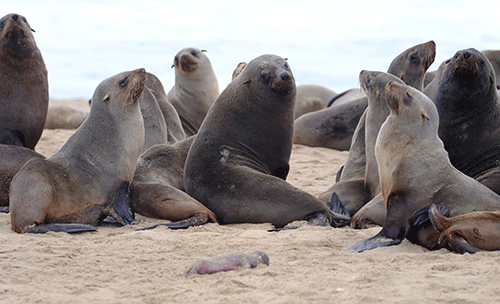WALVIS BAY – A large seal population is contributing to fish stocks but a sensible management of their numbers is more difficult than many would acknowledge.
Fisheries minister Derek Klazen has said the growing seal population cannot just be culled due to international agreements it is a signatory to.
This is despite the about 1.5 million seals eating about two million metric tonnes of fish per year.
Klazen was responding to a motion by member of parliament Mike Kavekotora in the National Assembly regarding Namibian fish stocks facing depletion as a result of seals stock proliferation.
Kavekotora raised concern about seal harvesting over the decade.
Currently, only two companies have seal harvesting quotas. The seals processing factory in Henties Bay and the National Youth Council (NYC) are harvesting seals.
However, their operations are seasonal and the companies over the years struggled to penetrate bigger markets due to the sensitivity around seal culling.
The TAC for pups and bulls over the five years from 2017 to 2021 remained the same at 60 000 pups and 8 000 bulls.
According to Klazen, in terms of the Marine Resources Act, Act 27 of 2000, seals are defined as living marine resources.
He said managing seals is a multifaceted operation, governed by many national, regional and international laws, agreements and conventions; hence, Namibia, as a member of the international fisheries management community, cannot manage it in isolation.
“The issue of seals is not as simple as it may be portrayed to be. They are classified as marine resources and should ideally be managed similarly to all other marine resources. However, Namibian fisheries management law is entangled in other international fisheries management conventions to which Namibia is a party,” Klazen said.
According to him, this makes it complicated, as international environmentalist groups and consumers, particularly in Western countries, pose challenges to national, sovereign fisheries management efforts.
He said seals are one of the quota-managed species, which means a total allowable catch for seals harvesting is first determined before quotas are allocated to individual right holders to harvest their allocated quotas for that season.
“While we are deliberating, let me highlight that Namibian seals are listed in the appendix of the Convention on International Trade in Endangered Species of Wild Fauna and Flora (CITES) as a threatened species. This listing on the CITES means that species are not necessarily threatened with extinction, but trade must be controlled to avoid utilisation that is incompatible with their survival, Klazen said.
However, he says it is not the number of seals one needs to be concerned about, but the amount of fish they consume.
“It is not the number of seals that is a concern; it is more the quantities of fish these seals eat per day. One adult seal eats approximately 3.8 kilogrammes of fish per day. This means 1.5 million seals would eat around two million metric tonnes of fish per year. This amount is about four times more than the annual combined TAC for hake, horse mackerel and monk per year,” Klazen said. -edeklerk@nepc.com.na


